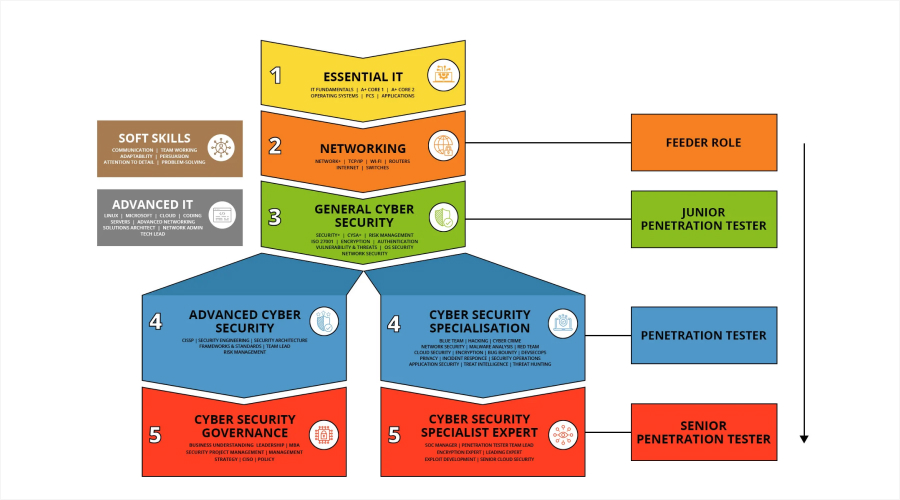
One of the most demanding positions in the cyber security domain is Web App Penetration Tester. Today, when almost everything is done over the Internet, web applications are at the core of most activities that are being pursued. Hence, securing these applications becomes a priority like never before.
This guide takes you through a stepwise roadmap toward acquiring some of the requisite skills, knowledge and certifications necessary for a successful career as a web app penetration tester. Whether just getting started or looking simply for improvement in the skills developed, use this guide in navigating your way to that level of specialty for web app security.
What does a Web App Penetration tester do?
A Web App Penetration Tester is the most specialized security professional, particularly skilled at investigating and exploiting web applications. In simple terms, his task consists of the modeling of a cyber attack on the website or some web application.
For that purpose, a hacker seeks out weaknesses which such security flaws he or she might exploit for some criminal goal. The provision of various tools and the use of some technologies in testing the security of web applications are employed, including vulnerability scanning as well as manual testing.
Penetration testers also establish the general security posture of web applications through risk assessments and recommendations on how to improve. Testers collaborate with the development teams to rectify vulnerabilities found in the application, making sure that the application is safe from all kinds of external threats.
Pre-Required Technical Skills and Soft Skills (table)
| Category | Pre-Required Technical Skills | Pre-Required Soft Skills |
|---|---|---|
| Networking Knowledge | Knowledge of TCP/IP, HTTP/HTTPS and DNS. | Should have clear and concise communication skills. |
| Web Technologies | Familiar with HTML, CSS, JavaScript and frameworks. | Should have abilities of collaboration and teamwork |
| Tools and Techniques | Experience in tools like Burp Suite, OWASP ZAP and Metasploit. | Skills like problem-solving and critical thinking |
Programming Skills | Skilled in scripting (Python, Bash) and web languages (PHP). | Flexible to new technologies and environments. |
| Operating Systems | Knowledge of Linux/Unix and Windows environments. | Able to manage tasks and ability to prioritize tasks. |
| Vulnerability Testing | Ability to manually identify and exploit vulnerabilities (e.g., SQL injection, XSS). | Conflict resolution and negotiation skills. |
| Security Standards | Should Know OWASP Top 10 and other security frameworks. | Ethical integrity and professionalism. |
Web App Penetration Tester RoadMap 2026

1. Build a Strong Foundation in Cybersecurity
Gaining a strong foundation in computer science basics like algorithms, data structures and programming is important for analyzing systems and finding vulnerabilities. Good knowledge of OS specifically in Linux (Kali Linux) and Windows is important in penetration testing, as a tester you have to frequently interact with these environments.
Additionally, mastering the protocols of networking like TCP/IP, HTTP/S and DNS helps in recognizing vulnerabilities in communication, while having knowledge of programming languages (Python, JavaScript, PHP) and scripting languages (Bash, PowerShell) allows you to automate tasks and write custom exploits.
2. Cybersecurity Fundamentals
Grasping a basic security concept such as encryption, hashing and authentication with session management is basic to the identification of weaknesses in both web apps and networks. Knowing the OWASP top 10 vulnerabilities, specifically SQL Injection, XSS and Broken Authentication, will keep you ahead in web application security.
Understanding security protocols like SSL/TLS and HTTP headers will be key to securing communication with integrity in data, which serves both the attacker and defender in penetration testing.
3. Penetration Testing Tools & Methodologies
Kali Linux with many tools for penetration testing must be mastered for a smooth and efficient exploitation and assessment of vulnerability. Major tools used for web vulnerability scanning include Burp Suite and OWASP ZAP, for using known vulnerabilities with Metasploit, network and web server scanning by Nmap and Nikto and analyzing the network traffic with Wireshark.
Understanding methodologies like OWASP and PTES will make one follow structured approaches in pen testing so that there is proper testing from reconnaissance to the reporting process.
4. Web Application Security
To know and identify vulnerabilities in web applications, one should be familiar with web technologies such as HTML, CSS and JavaScript, as well as how the front-end and back-end building.
Common vulnerabilities include SQL Injection, XSS and CSRF, which give the attacker the ability to manipulate the database, execute malicious scripts or perform actions that are not authorized. In addition, some other insecure deserialization and broken authentication can cause remote code executions or unauthorized access.
5. Hands-On Practice
Engage in CTF challenges in order to simulate real security problems you may face when you are involved in penetration testing. Participate in bug bounty programs through services such as HackerOne and Bugcrowd, thus having access to live systems and train yourself in responsible disclosure with valuable experience.
Setting up vulnerable web applications like DVWA, WebGoat, or Juice Shop provides an environment to test known vulnerabilities on safe systems for furthering your skills.
6. Advanced Topics
Penetration testing skills on the advanced level include gaining system access by exploiting web vulnerabilities, exploitation techniques such as buffer overflows and privilege escalation.
You will also require an understanding of cryptography because the security measures used by algorithms such as encryption algorithms and hashing functions can be studied; then you will find a weakness in their implementations to be exploited.
Further learning Web Application Firewalls and other advanced web attacks, including XXE, SSRF and directory traversal, helps bypass the security measures put in place.
7. Stay Updated
Keep up to date in cybersecurity with blogs like KrebsOnSecurity and The Hacker News that follow the latest vulnerabilities and exploits. Contributing to open-source security projects helps learn from experienced professionals and expands the network and reputation in the security community.
8. Soft Skills
Developing effective report-writing skills is an essential requirement for penetration testers, as it will ensure that the findings are communicated to the client regarding the vulnerabilities and their associated risks.
Critical thinking and problem-solving abilities are equally essential since penetration testing requires creativity in the identification and exploitation of vulnerabilities. Developing these soft skills will help you convey complex technical information and think strategically during testing engagements.
Certifications Exams for Penetration Testers

- CompTIA Security+: It is a basic level of security certification that encompasses various security aspects, including network security, compliance and threat management.
- Certified Ethical Hacker: CEH is famous worldwide, but more especially in the world of ethical hacking certification. This certificate encompasses all methodologies, tools and techniques of penetration testing. Therefore, it is the starting point for any penetration testing candidate interested.
- Offensive Security Certified Professional (OSCP): The skills of OSCP certification that focus on the penetration of testing and exploitation. It is a manual that is, you will be asked to conduct a physical penetration test in a safe environment.
- GIAC Web Application Penetration Tester, GWAPT: Specializing in web application penetration testing and good for only the ones interested in web security.
- Certified Web Application Security Specialist (CWASS): This is a specific certification that is related to web application security. It is a course that focuses on what is specific to web applications and includes vulnerabilities that are specific to the web.
How to Get First Role in Penetration Testing
- Understanding Networking Basics: First, have a basic understanding of network basics and learn how one computer communicates with another over the internet. Then learn fundamentals like computer networks and protocols.
- Internship Opportunities: Get your hands-on possibilities for internship placements in the field of cybersecurity or networking and put these into practice in the real world.
- Certifications in Cybersecurity: Get the certificates that are seen in the industry such as CompTIA Security+, Certified Ethical Hacker (CEH), and Cisco’s CCNA certification, which you can prepare through CCNA Training, and which will greatly help you enhance your skills and make your profile more credible.
- Attending Security Conferences: Get in touch with people from the technical community, keep yourself informed about the most recent trends and get information from leading experts in talks taking part in cybersecurity and network conferences.
- Building a Strong Resume: Skills you have, certificates you’ve obtained and experiences you have that are pertinent to the job you are applying for should be the main focus of your resume.
- Improving Communication Skills: The acquisition of clear communication skills is essential for the ease of presenting technical materials to both technical and non-technical audiences.
Further Career Advancement Tips
- Master Networking, Cryptography, OS and programming with Python and Ruby.
- Understand buffer overflow, code injection and privilege escalation.
- Understand how WAFs work and their bypass techniques.
- Develop custom tools and master Metasploit, Nmap, Burp Suite, Wireshark and Kali Linux.
- Learn tools related to AWS, Azure and GCP.
- Study security research and new technology, i.e., serverless, containers.
- Web and mobile applications and IoT security specializations are also a very good path.
Also Read: Mutation Testing Vs Regression Testing
Conclusion
In conclusion, it shows how essential web app penetration testers are to web applications and organizational security by spotting the possible vulnerabilities that lead to actions that are carried out as recommendations in eliminating risk and ensuring safe webs and guarded data, so nothing dangerous happens in those spaces.






